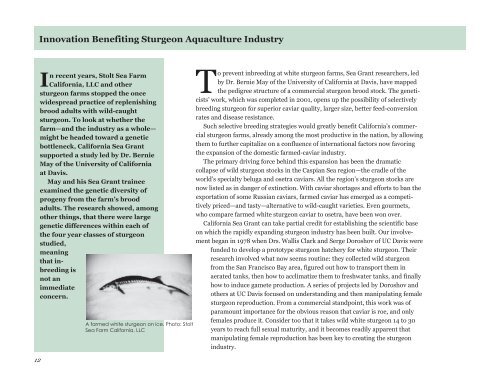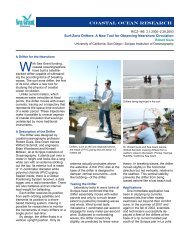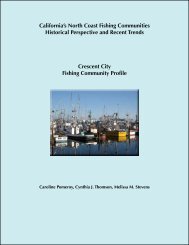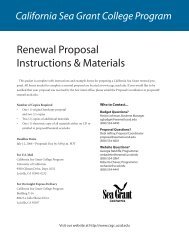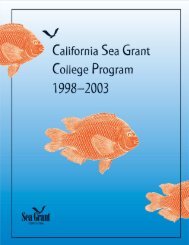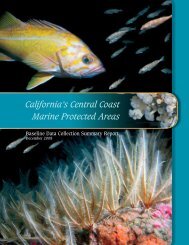2001â2002 - California Sea Grant - UC San Diego
2001â2002 - California Sea Grant - UC San Diego
2001â2002 - California Sea Grant - UC San Diego
Create successful ePaper yourself
Turn your PDF publications into a flip-book with our unique Google optimized e-Paper software.
Innovation Benefiting Sturgeon Aquaculture Industry<br />
12<br />
In recent years, Stolt <strong>Sea</strong> Farm<br />
<strong>California</strong>, LLC and other<br />
sturgeon farms stopped the once<br />
widespread practice of replenishing<br />
brood adults with wild-caught<br />
sturgeon. To look at whether the<br />
farm—and the industry as a whole—<br />
might be headed toward a genetic<br />
bottleneck, <strong>California</strong> <strong>Sea</strong> <strong>Grant</strong><br />
supported a study led by Dr. Bernie<br />
May of the University of <strong>California</strong><br />
at Davis.<br />
May and his <strong>Sea</strong> <strong>Grant</strong> trainee<br />
examined the genetic diversity of<br />
progeny from the farm’s brood<br />
adults. The research showed, among<br />
other things, that there were large<br />
genetic differences within each of<br />
the four year classes of sturgeon<br />
studied,<br />
meaning<br />
that inbreeding<br />
is<br />
not an<br />
immediate<br />
concern.<br />
A farmed white sturgeon on ice. Photo: Stolt<br />
<strong>Sea</strong> Farm <strong>California</strong>, LLC<br />
To prevent inbreeding at white sturgeon farms, <strong>Sea</strong> <strong>Grant</strong> researchers, led<br />
by Dr. Bernie May of the University of <strong>California</strong> at Davis, have mapped<br />
the pedigree structure of a commercial sturgeon brood stock. The geneticists’<br />
work, which was completed in 2001, opens up the possibility of selectively<br />
breeding sturgeon for superior caviar quality, larger size, better feed-conversion<br />
rates and disease resistance.<br />
Such selective breeding strategies would greatly benefit <strong>California</strong>’s commercial<br />
sturgeon farms, already among the most productive in the nation, by allowing<br />
them to further capitalize on a confluence of international factors now favoring<br />
the expansion of the domestic farmed-caviar industry.<br />
The primary driving force behind this expansion has been the dramatic<br />
collapse of wild sturgeon stocks in the Caspian <strong>Sea</strong> region—the cradle of the<br />
world’s specialty beluga and osetra caviars. All the region’s sturgeon stocks are<br />
now listed as in danger of extinction. With caviar shortages and efforts to ban the<br />
exportation of some Russian caviars, farmed caviar has emerged as a competitively<br />
priced—and tasty—alternative to wild-caught varieties. Even gourmets,<br />
who compare farmed white sturgeon caviar to osetra, have been won over.<br />
<strong>California</strong> <strong>Sea</strong> <strong>Grant</strong> can take partial credit for establishing the scientific base<br />
on which the rapidly expanding sturgeon industry has been built. Our involvement<br />
began in 1978 when Drs. Wallis Clark and Serge Doroshov of <strong>UC</strong> Davis were<br />
funded to develop a prototype sturgeon hatchery for white sturgeon. Their<br />
research involved what now seems routine: they collected wild sturgeon<br />
from the <strong>San</strong> Francisco Bay area, figured out how to transport them in<br />
aerated tanks, then how to acclimatize them to freshwater tanks, and finally<br />
how to induce gamete production. A series of projects led by Doroshov and<br />
others at <strong>UC</strong> Davis focused on understanding and then manipulating female<br />
sturgeon reproduction. From a commercial standpoint, this work was of<br />
paramount importance for the obvious reason that caviar is roe, and only<br />
females produce it. Consider too that it takes wild white sturgeon 14 to 30<br />
years to reach full sexual maturity, and it becomes readily apparent that<br />
manipulating female reproduction has been key to creating the sturgeon<br />
industry.


